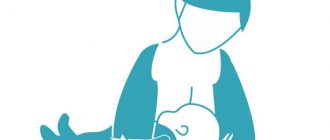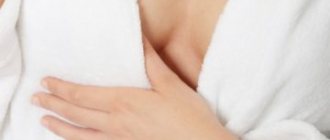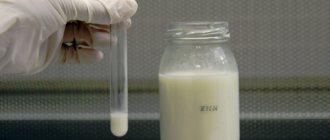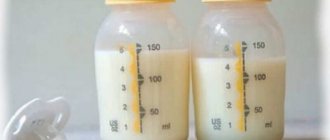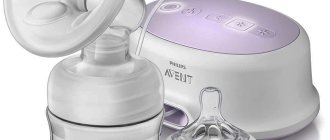Breastfeeding systems have recently become especially popular among young and experienced mothers. Simple devices allow, at the same time as feeding the baby with mother's milk, to saturate the baby with complementary foods. Thanks to this, the baby receives the beneficial elements of breast milk, supplemented with artificial compounds. It is recommended to purchase a device for supplementary feeding at a pharmacy or make it yourself; there will not be any particular difficulties.
SNS is a simple device recommended for mothers whose children do not receive adequate nutrition due to a lack of milk. The system is a thin long tube. One end is attached to the nipple of the female breast, the other to a container with the mixture. The reservoir is placed on a special tripod. Some models allow you to attach the container directly to the chest, which is more convenient - feeding can be done outside the apartment - at a party, in nature.
A device for supplementary feeding of infants allows the baby to simultaneously receive a portion of mother’s milk and nutritional composition. The system is easy to use and maintain - it is easy to clean, and if used correctly it will last a long time.
Advantages of SNA
If you carefully study all the advantages of the supplementary feeding device, it is easy to see that there are many advantages.
Among the most important advantages of mothers feeding their baby with the help of SNS are:
- without much difficulty it is possible to introduce complementary foods into the child’s diet;
- The device can be used repeatedly;
- thanks to regular stimulation of the female breast, more milk is produced;
- the baby gets excellent breastfeeding training due to the artificially created vacuum;
- maternal instincts are supported and stimulated;
- A bond is established between mother and baby.
What problems can it cause?
Despite the many positive qualities of the supplementary feeding system, it often happens that women using the device to feed their baby encounter some difficulties. Among the disadvantages is the child’s refusal to feed in the future without the use of SNS.
It is almost impossible to cope with a baby’s habit, so you have to give up trying to accustom your baby to mother’s milk, which is obtained without any device.
Another drawback that women note is that difficulties often arise when trying to properly insert the tube into their child.
It turns out that in the absence of dexterity and experience, not everyone can do this, so you have to repeat the process several times. This causes irritation in the baby, and he is able to refuse feeding altogether.
If a reservoir of supplemental mixtures is attached to a woman's breast, the patch often leaves behind red marks or irritation.
On sensitive skin prone to irritation, a profuse rash often appears. In such cases, you have to use a tripod to support the container or temporarily abandon the use of the system.
How to make it yourself
The supplementary feeding system is so simple that it is recommended to do it yourself. To make it, you will need a regular bottle from which babies are fed, and a catheter used in medicine for intragastric feeding (a transparent thin tube made of silicone with holes at the ends). Be sure to purchase a quality pacifier.
Step-by-step production of the system:
- Make a hole in the nipple; the hole should not exceed the diameter of the catheter.
- Place the tube into the bottle, be sure to use the end on which the fixative is located.
- Use a medical plaster to attach the second end of the tube to the female breast.
The system, made by yourself, is completely ready for feeding the baby, and is in no way inferior in efficiency to expensive devices offered at the pharmacy. It is not recommended to use other components to make the device - experiments can lead to a complete refusal of the baby to eat this way.
This will immediately affect growth and development; a child who does not receive enough nutrients will quickly lose weight.
There is only one way to prevent mistakes - by fully following medical recommendations and using the experience of other mothers who have already been convinced of the effectiveness of a simple device made by themselves.
Tricks of use
Using a system for supplementary feeding of a baby has its own secrets and tricks that will make the feeding process an enjoyable pastime for mother and baby. The first thing to remember is that it is recommended to keep the container with complementary foods not at chest level, but slightly lower. This forces the baby to make more effort to suck the milk, which stimulates the activity of the baby.
To increase the flow and quantity of donor milk, it is recommended to open a non-working transaction. Be sure to lift its end up and secure it over the female breast - this will avoid losses, not a single drop of the composition will leak.
Regularly closing the second (free) end allows you to create an imitation of feeding with tides. Be sure to do this with clean hands, pre-washed with soap - bacteria entering the tube threatens the penetration of microbes into the child’s body. Closing the free end of the tube has a positive effect on lactation. After such processes, the woman’s milk production is stimulated; often, after regular procedures, the need for supplementary feeding disappears.
How to properly organize supplementary feeding of a newborn at the breast - instructions, video
In addition to the Medela system, there are other methods of supplementary feeding:
| Way | pros | Minuses |
| bottle | Available | The baby is weaning from the breast; this method is suitable for complete artificial feeding |
| Syringe without needle | Available | Risk of weaning; for children older than one month, one syringe is not enough |
| spoon | Available | Most of the milk is spilled |
| Pipette | Available | The feeding process is long, because... one pipette is not enough |
| Haberman's sippy cup | No weaning | Need to buy |
Video on how to feed from a Haberman sippy cup:
| Soft spoon Medela | Picks up more milk and less spillage, unlike a simple spoon | Need to buy. The child may not like it |
Video on how to feed from a Medela soft cup:
| Cup | Available. Fast feeding and less colic, because... baby doesn't swallow air | Not suitable for children with poor swallowing reflex |
Video on how to feed a baby from a cup:
| Breastfeeding system | Increases mother's lactation and does not wean the baby off the breast. Reusable | Need to buy |
Before introducing supplementary feeding into a newborn’s diet, the daily milk intake is calculated. The daily volume of food for babies up to 1.5 months is 1/5 of the weight, for children 1.5-4 months - 1/6 of the weight, for a child 4-6 months - 1/8 of the weight. The amount that the newborn lacks is compensated by artificial supplementary feeding.
The baby's first supplementary feeding should not exceed 30% of the total amount of milk so that the tummy gets used to the new food.
The process of supplementing a newborn with formula depends on the feeding method, but the following rules are always followed:
- Supplementary feeding is given to the baby after he has suckled the breast.
- The mixture is prepared immediately before feeding.
- There is no need to force your child to finish the supplement if he is full.
- Reduce the mixture by the amount that the baby did not eat last time.
- At the end of feeding, it is better to give the baby the breast again.
Only mother's milk is absorbed well by the baby and at the same time receives the necessary nutrients. The mixtures cause changes in the intestinal microflora of the newborn, increasing acidity and the number of bacteria, so supplementary feeding should be given only when necessary. In order for the baby to continue to breastfeed with mixed feeding, it is necessary to improve the woman’s lactation and choose a feeding method in which the baby will not refuse breastfeeding.
SNS care
A prerequisite when using a supplementary feeding device is careful care. Mothers should remember that with such feeding, harmful bacteria can easily penetrate into a small body, causing diseases or even simple indigestion or an upset stomach.
Washing the system should begin with the bottle and nipple. They should be washed with a special detergent for children's dishes. Rinse under running cool water. You need to rinse for at least 2-3 minutes. Sterilize the bottle and nipple once a day. It is recommended to purchase several feeding containers at once and use them alternately. Rinse the tube thoroughly. It is not recommended to boil it - silicone can deform at high temperatures. If possible, change the catheter every week.
Be sure to thoroughly dry the system components. It is recommended to do this on a soft, clean cloth. Use for feeding only after thorough drying. The system for supplementary feeding of the child allows you to compensate for the lack of mother's milk, which often happens if a woman after childbirth was unable to put her lactation in order. Thanks to the device, the baby also gains excellent sucking skills, so there are no problems with breastfeeding in the future.
Even a self-made system allows you to cope with problems by actively supplying the child with the nutritional components necessary for growth and development.
Read about the story about the struggle for breastfeeding.
At 1.5 months, all that was left was feeding at night, and then half asleep. Only the bottle is in an alert state. I decided to do something about it. Therefore, I went to the residential complex for a consultation with a breastfeeding instructor. She looked at the seizure and advised on what needs to be done, including giving up bottles and pacifiers. I had experience of supplementary feeding from a syringe, but it turned out that supplementary feeding can be given from a spoon, soft spoon, sippy cup and SNS. She especially strongly recommended SNS, since breastfeeding stimulates milk production.
SNS was developed specifically for supplementary feeding of premature babies, children who find it difficult to breastfeed, or breastfed adopted children, and for the children of women like me who were trying to increase their milk supply and regain confidence in the breast.
You rarely find SNS in a pharmacy, but in Volgograd SNS is found in Volgogrofarm pharmacies
. We bought it for 1681 rubles in September 2014. It's quite expensive. Opening the box, I expected to see something completely different... But I saw only instructions, a bottle, a cap for the bottle, capillaries and an adhesive plaster.
So, SNS is a bottle with a cap and capillaries connected to it.
The set includes 3 types of capillaries, different in diameter: with large, medium and small permeability. They differ in color. I used the middle one.
The bottle holds 150 ml
liquids. But the division scale, like on many bottles, is not accurate.
Let me start by saying that SNA is not very convenient to use. First, the mixture is prepared and only then poured into a Medela bottle. To prevent the mixture from leaking when attached to the neck, you need to insert capillaries into the slots on the lids. But when the baby consumes the formula, periodically you have to pull the second capillary out of this slot and introduce air. Otherwise, it becomes difficult to suck out the mixture.
I always gave the breast first, the SNS with the formula was already hanging on my neck, and as soon as the child began to lose interest in the breast, I pulled the capillary out of the slot and a small pressure of the mixture again interested my son in sucking the breast.
Sometimes it’s true that my fear that my baby was hungry forced me to immediately connect the SNS, but over time I overcame it.
After a month, the amount of supplementary feeding decreased greatly. My son drank very little formula from the bottle and I gave it up. She fed and supplemented with milk from a spoon or syringe. With these devices there is much less hassle.
Many people wrote in reviews that the SNS gets clogged and is inconvenient to wash. I didn’t get anything clogged during this time. If one capillary became clogged, I poured boiling water into the bottle, closed the lid with the capillaries and pressed on the bottle. Everything was cleaned perfectly.
Another disadvantage is these adhesive plasters. They also irritated me. But what can you do? Plus, sometimes the mixture began to drip through the capillaries and everything ended up in it.
But if you want to return to breastfeeding, then you will hardly be able to do without a supplementary feeding system.
I do not agree with the opinion that it is only for children who take the breast. My son began to cry and demand a bottle almost immediately after putting him to the breast; he only sucked at the breast half asleep at night. And yet, SNS was able to draw him back to her breast and forget the bottle.
Supplementary feeding* is an ideal way to provide extra nutrition to breastfed babies. The system helps strengthen the unique bond between mother and baby, allowing them to achieve better and better breastfeeding results. This becomes possible because with the help of SNS, the baby can receive exactly the amount of additional milk that he needs, while continuing to feed from his mother's breast.
Choice of formula and types of supplementation
The optimal solution, when the problem is not lactation, but the weakness of the child, is expressed milk. It is safer for the baby’s body and does not cause negative consequences. If this is a problem, you need to include in your diet those supplements that are close to breast milk.
When the question arises of which formula to choose for supplementary feeding of newborns, you need to consider the following:
- The composition of the mixture must include the vitamins and compounds necessary for the baby in the correct quantities and proportions. Formulas adapted for one-month-old babies are made from cow's milk and demineralized whey. Supplementary feeding, where there is no such serum or there is little of it, is more suitable for children over 6 months.
- It’s better not to save money and choose a reputable manufacturer with a quality certificate. You should not take food from your hands.
- The mixture must be age appropriate.
- Do not forget about the expiration date and storage conditions.
Depending on the baby’s illness, you need to pay attention to the properties of the formulas: supplementary food for premature babies contains a lot of protein and vitamins, for children with intestinal problems - pribiotics, for babies with allergies - hypoallergenic. If a newborn has a deficiency of some element, the mixture is selected with a higher content of this substance.
Types of supplementary feeding for children:
| Dry | Liquid | |
| View | Powder in packaging | Packaging or bottle |
| Cooking method | Pour the powder into a container and pour boiled water at 38 degrees. Supplementary foods vary, so it’s best to read the instructions | Ready to eat, just need to warm up a little |
Important! Liquid mixtures have a short shelf life, so you need to check the date of manufacture.
Additional feeding system strengthens the bond
“Thanks to SNS, I can breastfeed again. This is a real gift of fate! I think this system opens up huge opportunities for a lot of women.” Christiana K.
The SNS system is designed to enable mothers to breastfeed in situations where breastfeeding would not be possible without the system, and to help the baby develop sucking skills. The system has the following advantages.
- It can be used by mothers who have low milk supply or who feel like they have low milk supply.
- It helps stimulate the mother's milk production through direct suckling at the breast.
- It can be used in cases where supplementary feeding is needed in addition to breast milk.
- This system trains the baby to suckle properly by creating a vacuum.
The additional feeding system is a reservoir that is filled with additional food. It can be placed on the mother's chest or on a tripod. Very thin, flexible tubes are attached to the mother's nipples and provide extra milk and nutrients as the baby feeds.
Benefits of SNS
This special feeding device provides extra nutrition for your baby while breastfeeding.
The reservoir can be placed on the mother's chest.
Very thin flexible tubes are attached to the mother's nipples.
The device can be used repeatedly after washing and treating in accordance with the instructions for use.
- Allows mothers to breastfeed in cases where this would not be possible without an additional system.
- Helps stimulate mother's milk production through direct breastfeeding.
- Trains the baby to suckle correctly by creating a vacuum.
- Stimulates, supports and develops parental instincts.
- Supports the unique bond between mother and baby.
- Allows breastfeeding of adopted children.
Literature
Literature
Niefert, M. & Seacat, J. Practical aspects of breast feeding the premature infant.
Perin Neonatol 12, 24-30 (1988).
— Niefert M. and Seacat J., “Practical aspects of breastfeeding preterm infants.” Perin Neonatol 12, 24-30 (1988). Related Products
Symphony PLUS smart card for Symphony breast pump
The Symphony PLUS smart card contains software with two different expression programs for the Symphony clinical breast pump. The INITIATE program helps mothers using a breast pump successfully initiate the process of...
Supplementary feeding systems come in different types and have recently become widespread among nursing mothers. SNS are a thin tube, one end of which is connected to the chest, and the other to a container with food. Thus, the baby can receive supplementary feeding directly while breastfeeding.
You can buy such a device (we have Medela and Lact-aid brand systems available) or make it yourself. How? Read below.
Baby supplementary feeding system - review
For children who do not have enough mother's milk, we have developed a special supplementary feeding system SNS Medela. A container like a bottle with expressed milk or formula is hung on the mother's neck with tubes downwards. They are glued with a hypoallergenic patch next to the mammary glands. When the newborn sucks at the breast, he will grab the tube along with the nipple. Together with mother's milk, supplementary feeding will be supplied to him, and the woman's lactation will improve.
With such nutrition, the child does not wean from the breast. After all, natural feeding requires effort to create a vacuum near the nipple, and when feeding from a bottle, food is easily accessible. To regulate the flow of milk and the efforts of the baby, Medela comes with three tubes of different widths; the large one delivers milk easily and quickly, but with a narrow neck the baby will have to work hard.
You only need to buy such a system once, and after use, rinse it according to the instructions. All components are made of safe polypropylene and silicone.
What problems can the SNS supplementary feeding system help solve?
Often nursing mothers begin to use such a system to reduce the time for supplementary feeding
when a child needs additional nutrition in large quantities and for a long time, for example, with a significant lack of milk, during relactation or induced lactation (breastfeeding an adopted child).
The baby shows more interest in the breast and sucks longer
if it feels a stable flow, which means it stimulates more milk production in the breast.
What problems can the supplementary feeding system cause?
The child can suck on a straw like a straw
, which means do not open your mouth deeply and do not stimulate your breasts.
In addition, the baby gets used to constant topping up
from the tube, which means he ceases to understand that milk is not released from the breast constantly, but intermittently. Therefore, there is a dependence on the system, both for the child and for the mother, who no longer knows how to feed the child without such an assistant.
One American study of 22 mothers who used such supplementation systems found that women had very different feelings about their experience. Some mothers viewed this device as a “necessary evil” without which breastfeeding is impossible, others complained that this device took a lot of their time and was difficult to use. 5 out of 22 women completed breastfeeding within a week of starting to use this device. 16 mothers breastfed for more than 6 months, one woman for 4.5 years.
Indications for the introduction of supplementary feeding to a newborn baby
Supplemental feeding is prescribed to an infant for certain diseases:
- Developmental defects that prevent breastfeeding.
- Diseases associated with the absorption of mother's milk.
- Long-term separation of baby and mother due to mother's illness when expressed milk is not enough.
- Taking medications by the mother that are contraindicated during lactation.
A healthy baby and mother do not need supplemental feeding, but in some cases mixed feeding may be necessary.
| Indications for introducing supplementary feeding to a child | |
| From the newborn's side | Mother's side |
| Hypoglycemia, low glucose levels do not change after breastfeeding | Sheehan syndrome |
| Weight loss greater than 10% of initial weight High sodium levels Lethargy | Lack of milk due to placental remnants in the uterus, after removal of which lactation returns to normal |
| Weight loss up to 10% due to delayed lactation in the mother 5 days after birth | Underdevelopment of the mammary glands |
| Baby's jaundice due to lack of milk or jaundice of the milk itself | Breast surgery, mammary gland pathologies and, as a consequence, lactation disorders |
| A weak child does not receive enough milk, despite the mother's good lactation | Severe pain during feeding that cannot be eliminated |
| Introduction of additional vitamins, amino acids and minerals | The birth of twins when there is not enough milk, or an adopted baby |
| Prematurity and low weight, which the newborn gains faster with additional feeding | C-section |
| The mother's Rh factor is different from the baby's Rh factor | Major blood loss during childbirth |
A doctor can definitely determine whether supplementary feeding of a child with formula is necessary. He looks at the following indicators of the baby, which are a signal for the necessary mixed nutrition.
This may include:
- The baby sucks weakly at the breast.
- Weight loss greater than 10% after birth. Weight gain in the first 3 months of life is 0.5 kg monthly;
- The frequency of urination is less than 10 times a day. The doctor calculates the required number of urinations per knock depending on the baby’s age and adds 50 ml of supplementary feeding for each deficiency. This method is combined with the next point, because The child may urinate rarely, but a lot.
- Calculating the amount of urine using the N.F. formula. Filatova.
- After feeding, the baby should be calm, except in cases of abdominal colic, and not ask for the breast every 1.5 hours.
- Calculating your baby's milk intake by weighing before and after feeding.
If the described problems are not observed, but there is a feeling that the baby is not eating enough, then you can try a safe option for supplementing the baby’s feeding - expressed milk. By the evening, a woman's lactation gradually fades away, and a larger amount is released in the morning.
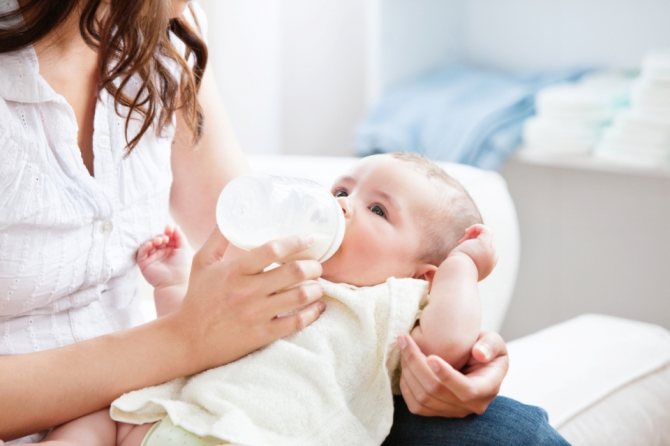
To make it easier for a newborn to get enough in the evening, the mother should express milk in the morning and feed it to the baby by night. This method has no side effects on babies under six months, as if supplemented with formula feeding.
It is important to understand that some signs are not symptoms of insufficient lactation:
- The baby cries during feeding and presses his legs to his stomach - this is probably colic.
- The newborn does not sleep well at night. The reason may be not only in diet, but also inappropriate room temperature, gases, hard bed, teeth pain.
- Weak milk expression is not a sign of poor lactation. If you hear the baby smacking his lips and swallowing during feeding, there is enough milk.
Supplementary feeding of a newborn while breastfeeding is not an ordinary nutritional supplement; it is a necessity, without which the baby loses strength. Sometimes a mother experiences a shortage of milk due to the child’s sharply increased need, but after a week the glands begin to produce enough. You should not feed your baby unnecessarily. The solution may be to feed first one breast, then the other.
Tips for nursing mothers about SNS
What tips can help a nursing mother when using breastfeeding systems?
1) In order for the breasts to receive good stimulation, it is desirable that feeding lasts at least 20-40 minutes.
Therefore, before inserting the tube, achieve a deep latch on the breast and make sure that the flow of milk or formula from the tube is not too fast.
How to achieve this? By raising the supplement bottle higher, you speed up the flow, and by lowering it below breast level, you slow it down. Also, some systems are sold with three sizes of tubes, thanks to which you can slow down or increase the flow rate.
2) Exactly the same strategies can be used when weaning a child from the supplementary feeding system, if the amount of breast milk has increased or the baby is already 6 months old and receives sufficient complementary foods.
3) Try lowering the height of the bottle to slow down the flow of milk from the straw. Also try to do some feedings without using a tube, for example in the morning when there is a lot of milk.
Real stories of nursing mothers from SNS
“As I already wrote to you, I have vision problems, so I cannot feed the baby with a spoon or syringe on my own, my relatives help. When supplementary feeding was introduced at each feeding, I began to bottle feed, since there was no other choice. I read that there is also such a feeding method as the SNS (supplementary feeding system) - as I understand it, this is a bottle that hangs on the mother’s neck and a thin capillary extends from it, which is fixed next to the nipple, the baby grabs both the breast and it, judging by the reviews This device almost eliminates the possibility of the baby refusing to breastfeed. I have not yet found such a device in our city. Tell me, how do you feel about this method of supplementary feeding?”
In general, I feel good about it, although this system is not universal and cannot be recommended in all cases.
“I tried finger feeding with the SNS system. I ate well for two days, then a scandal with refusal began.” “A week ago I completely gave up breastfeeding. Arches, screams, etc. I bought an additional system. feeding SNS - I took 2 naps and that’s it.” “He began to refuse to breastfeed due to supplemental feeding from a bottle, he does not always suckle when the milk in the breast comes to an end, and he quits with irritation. Sometimes the breast immediately drops, without waiting for the tide to flow, and the milk becomes less. I read the comments, bought SNS, but I can’t get it to work. Help me please!"
It is possible to return the baby to the breast, but a lot depends on the volume of formula and the age of the child - it may not be so easy. The SNS system is only suitable if there is no breast refusal, otherwise a cup or a special spoon is better.
“At first we alternated between breastfeeding and formula (we bought a special bottle - imitation of a nipple, dosage of droplets according to age) - the milk began to decrease with such feedings. And gradually my son gave up breastfeeding completely during the day. With screams and tears, we finally weaned ourselves off the bottle. I read about such a supplementary feeding system - using a thin tube, one end of which goes into the baby’s mouth, and the other into a bottle with formula. And for two weeks now we have been eating like this - “breast formula”, 90 grams every 2.5-3 hours. Breast without formula refuses to take. Several times I tried to give only the breast, but there was no effect - she would scream, suck for 3 minutes and fall asleep. Tell me, is it even worth abusing a child like that - trying to renew breastfeeding?”
The situation is complicated. This is not the first time I have encountered the problem of children’s dependence on the SNS supplementary nutrition system, although it is designed to help establish breastfeeding. It is definitely possible to return the baby to the breast, but it will not be possible without tears.
I suggest you give up SNS and switch to supplemental feeding with spoon-fed formula. Give the mixture in equal volumes in quantities of no more than 60 grams at a time. Offer breasts at your request no more than once an hour, mainly after supplementary feeding and after rocking to sleep. If she starts crying, close her chest and distract her.
Plus, the following conditions must be observed for at least the first week: 1) no walks and guests, no visits to doctors 2) skin-to-skin contact with the child 3) gradual abolition of the pacifier 4) sleeping together and bathing together in a large bathtub.
“I had to give up breastfeeding for a month, I want the milk back. There is a feeding system. Is it possible to increase lactation using a breast pump (there are two available) or are they only intended for expressing?
Yes, you can increase your lactation with a breast pump, both of yours are good. You need to pump regularly every 3 hours for 10-15 minutes on each breast. If you have two breast pumps, you can express at the same time, if possible. It makes sense to use the SNS feeding system if the baby is breastfeeding. That would be great. You will be able to supplement and stimulate your breasts at the same time. I would recommend that you contact one of the consultants in your city (see website/consult) and work with him, this will increase efficiency. You will succeed, at this age it is quite possible!
“The colostrum arrived only on the 9th day - there was an urgent operation to stop the bleeding. Now the milk is flowing drop by drop, I have slowly taught the baby to take the breast, but he only sucks if I put on the SNS at the same time. What to do?"
You can stimulate lactation by pumping for 15 minutes on each breast every 3 hours. And you should also give up SNS. Indeed, it happens that this system leads to addiction and then the child does not want to suckle at the breast without a tube. Try breastfeeding without a tube every hour, and supplementary feeding from a cup every 3 hours. Write about your successes!
It’s not easy to find non-standard children’s toys, and a breastfeeding doll, which I once wrote about, is generally difficult to find on our Internet. It's a pity - there would be demand!..
Introduction
The system for supplementary feeding at the breast allows a nursing mother to supplement or supplement her baby with expressed milk, formula, a glucose solution to which colostrum is added, or simply water with glucose, without using bottle nipples. Early use of pacifiers and bottles can cause the baby to become "bottle addicted" or develop "nipple confusion" because it interferes with the baby's ability to latch onto the breast correctly. In fact, the child does not confuse anything
. The child knows exactly where the wind is blowing. If first - especially in the very first days - he receives a breast with a little milk and a weak flow, and then a bottle with a strong flow, most babies quickly figure out what's what
The more correctly the baby takes the breast, the easier it is for him to get milk, especially if the mother has little of it. In the first days there is no excess milk, but there is enough for the baby to suckle it. But if a baby, due to poor attachment, is unable to properly suck milk from the breast, he may quickly fall asleep during feeding or arch at the breast when the flow of milk slows down. As a result, the baby may refuse to breastfeed, be very restless during feeding, have trouble gaining weight, lose weight, and in the first week this can even lead to dehydration. Mom may experience cracked nipples. Although artificial nipples do not always cause problems, using them when things are already going wrong rarely improves the situation and often makes the situation worse. I don't believe the "new" bottle nipples are any better than the ones that came before. Supplementing at the breast is a much better method of supplementation if supplementation is truly needed (although latching on correctly will often allow the baby to get more milk and thus avoid supplementation). This is more convenient than using a syringe without a needle, finger or cup feeding, or any other method because the baby is at the breast and suckling. Children, just like adults, learn by doing. Moreover, a baby who is supplemented at the breast also receives breast milk from the breast. And breastfeeding is far from just milk. Why is supplementary feeding at the breast preferable?
- Babies learn to suckle when they suckle at the breast
- Mothers learn to breastfeed when they breastfeed
- The baby continues to receive your milk, even while being supplemented
- The baby will not refuse the breast, which can be very likely if he is not supplemented at the breast.
- Breastfeeding is more than just breast milk
Breast feeding systems
Translation: Ada Torchinova Editing: Olga Yakovenko, Maria Sorokina Proofreading: Tatyana Romanova If your baby needs supplemental feeding with breast milk or formula, the breast supplementation system will allow you to provide additional nutrition right during breastfeeding. This helps increase milk supply and maintain the special feeding relationship.
When will a supplementary feeding system come in handy?
- If you are supplementing your baby with formula, the system will allow you to increase your milk supply and avoid using bottles.
- This is how you can breastfeed your adopted child.
- You can give your baby the special feeling of closeness that comes with breastfeeding while you work to increase your breast milk supply.
- A baby who refuses to breastfeed may be more willing to suckle with such a system.
- The system allows you to continue breastfeeding even if your milk supply is reduced, for example, due to certain health problems, after breast surgery or injury.
- Sometimes a breastfeeding system can help a baby who cannot breastfeed effectively due to health conditions. Attention: the system can only be used if the child can obtain sufficient nutrition in this way.
How it works?
With this system, you can give your baby all the necessary supplementary feeding right during breastfeeding. No bottles with pacifiers needed! You can hang the container with supplementary food on your neck or place it nearby at approximately the same level. The baby will gradually suck the supplement through the tube, while he will suckle at the breast, stimulating the production of breast milk. Plus, it will save your time!
How to use the system?
Insert the probe into the baby's mouth at the same time as the breast, at the very beginning of feeding. Place the tube between your upper lip and your tongue. If your baby doesn't like the feeling of the probe on the roof of his mouth, try placing it along the tongue. You can also carefully insert the tube into the corner of the mouth when the baby has already taken the breast well. Typically, you want the tube to extend beyond the tip of the nipple by about 6mm, as the nipple enlarges during feeding. You can secure the probe to your chest with a fixing medical plaster. It is usually more convenient to stick the patch along the tube rather than across it. Some parents use regular patches, placing the tube under the non-stick part in the middle. In this case, the tube can be easily removed, and the patches will remain in place. This will avoid skin irritation, and you won’t have to look for a convenient place for the probe every feeding. Below in the “Selecting a System” section we compare various purchased and homemade supplementary feeding systems.
Good grip
It is very important that when using the supplementary feeding system, the baby latch onto the breast deeply. Seek help, if necessary, work on postures and attachment so that the baby gets milk not only from the system, but also from the breast. While using the system, you will see how the supplementary food moves through the tube into the baby's mouth. To begin, adjust the position of the tube and the height of the container so that milk begins to flow to the baby as soon as he begins to suck. Check that the flow is not too fast, especially in case of heart problems, breathing problems or prematurity.
Types of supplementary feeding
Expressed milk
Your breast milk is the best supplementation option. If your baby is not suckling effectively, pumping will help maintain and increase your milk volume. Supplement your baby with breast milk before giving formula. To get the maximum benefit from breast milk, you should not mix two types of supplements in one container. The contents of the system do not need to be heated - moving along the probe pressed to your body, the supplementary feeding will warm up sufficiently.
Baby formula
The most common type of infant formula is dry powder. Such mixtures are more accessible than liquid ones, but, unfortunately, they can clog the system probe. In addition, such mixtures are not sterile, so when preparing them you must always follow WHO instructions. Ready-to-use liquid formulas are less likely to clog the system, and besides, such nutrition may be more convenient if you feed your baby on a walk or are at home alone without helpers.
Washing and sterilization
When feeding your baby formula, follow the equipment manufacturer's instructions and WHO recommendations for cleaning and sterilization. For any type of supplementary feeding, wash the system or soak it in a container of water immediately after use - if the milk dries inside the system, the probe will have to be thrown away. After each use, disassemble and wash the system with hot water and detergent, directing the water flow through the probe using the bottle or syringe that is usually included. Rinse with clean water and dry. Sterilize the system at least once a day.
We are moving away from supplementary feeding
Start feeding with the system closed. When your baby stops swallowing regularly, open the supplemental feeding stream. If the baby does not latch on, turn on the supplementary feeding flow at the very beginning of feeding. Pour a little more supplement into the system than you think your baby needs. Gradually, the volume of milk in your breast will increase, and the baby will fill up, leaving more and more milk in the system.
Contact us for support
The support of a volunteer consultant and the LLL team can be useful for all families using a breastfeeding system. You can also call a lactation consultant, such as an IBCLC or AKEB member, to your home.
System selection
Disposable bag system
This system consists of a sterile disposable bag and one probe. Milk flows to the baby only during sucking. The system can be used unnoticed by others, because the bags are not bulky and do not make sounds. In addition, you can feed lying down without fear of leaks. When the baby nurses, the flow of supplemental feeding increases as the flow of milk from the breast decreases. This mechanism encourages proper sucking and the mammary gland receives excellent stimulation. (Unfortunately, at the time of publication of this translation, systems with disposable bags are not available on the market in the Russian Federation - editor's note)
Bottle system
This system consists of a bottle and tube for each breast, which is especially convenient if you change breasts during feeding. Often the kit includes tubes of different diameters. The kits can be washed, sterilized and reused. A constant flow of supplemental feeding can lead to ineffective sucking, so try a medium-bore tube first. To stop the flow of supplementary feed, clamp the tube into the grooves on the bottle cap. Before you release the tube and continue feeding, raise any part of the tube above the level of the liquid in the bottle to avoid leaks. When you lower the tube, supplemental feeding will begin to move through the tube, even if the baby is not actively sucking. Adjust the flow rate so that the baby has to actively suck to obtain milk - for this you can use a probe of a smaller diameter or place the bottle lower. To increase the flow rate, on the contrary, choose a larger diameter tube or raise the bottle.
Homemade system
If you plan to use the system for a short time or want to try this supplementation method first, you can make a system using a regular baby bottle, pacifier and baby nasogastric tube (sizes 3.5 - 6). Probes can be purchased at large pharmacies, medical supply stores, or online stores. Make a small hole in the nipple of the bottle, such that the end of the probe fits there. The closer the probe fits to the edges of the hole, the lower the risk of leaks. Insert the tube into the hole and attach the nipple to the bottle in the usual way, so that the end of the probe is immersed in the supplement. The tip of the probe is rounded and will not hurt the child’s mouth. Make another hole in the nipple of the bottle or use a nipple with a hole for air circulation - as the volume of supplementary feeding decreases, air will fill the bottle and the baby will not have to suck harder. The bottle must be held vertically. Many mothers use a small bottle, placing it in the bra cup. This method allows you to use the system unnoticed by others. Nasogastric tubes should not be steamed or boiled. Change the probe when it begins to lose flexibility, usually after about a week (editor's note from LLLRF: other sources indicate a shorter period, once a day or every few days, see notes [2], [3], [4] ).
(Editor's note: here are handy instructions for assembling a homemade system with pictures).
Attention! The use of artificial breast milk substitutes unless absolutely necessary for the safety and well-being of the child's health may lead to early cessation of breastfeeding, threaten the health of the child, and may also have social and financial consequences. Once you stop breastfeeding, it will not be easy to resume.
Nursing Supplementers Authors: Karen Butler, Sue Upstone and LLL UK Moms Photos courtesy of Lynn Adams, Rae Vacher Lowe and Alison Widdup. And Anastasia N.
Note from the editors:
- This article should not be considered medical advice. Contact your health care provider if you have any questions about your health or the health of your child.
- The tubes used to make a homemade breastfeeding system are very difficult to clean and require frequent replacement. Feeding tubes for newborns are not intended for boiling or steam sterilization. The Royal Women's Hospital in Australia recommends replacing tubes and syringes (used to flush them) every 24 hours. Canadian pediatrician J. Newman says that with thorough washing, these probes can be changed every few days.
- If you are using a homemade breastfeeding system, you should carefully inspect the tubes for signs of wear. It is also worth keeping in mind that the probes may look clean on the outside, but the inside may be contaminated with bacterial microorganisms.
- If your baby is premature or particularly vulnerable to infections, then this requires additional monitoring and careful hygiene for a homemade breastfeeding system. More frequent changes of feeding tubes are recommended.
- Feeding tubes must be cleaned immediately after use, as milk residues can quickly dry out. Using a syringe, rinse the probe three times with chilled BOILED water in a volume of 10 ml. Be aware that warm water may cause the milk to coagulate, which may make rinsing difficult. Some authors recommend following the cold water rinse with an additional rinse with hot water and soap, and then rinsing the tube thoroughly again with cold water. After this, the washed probe should be shaken, which will remove most of the water from inside. And then it should be dried and placed in a clean container until next use.

